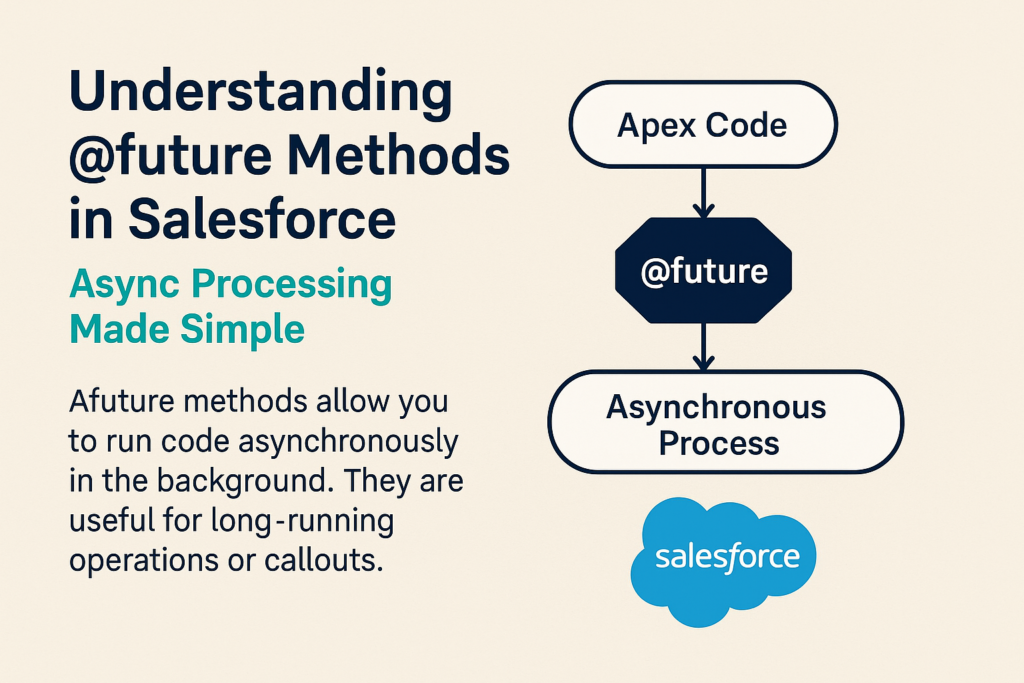Understanding @future Methods in Salesforce: Async Processing Made Simple
What is a @future Method?
In Salesforce, a @future method is an asynchronous Apex method used to run processes in the background—after the current transaction has been committed. This is especially useful when you’re performing time-consuming tasks or callouts that shouldn’t delay a user’s experience.
🔧 Syntax
apex
@future
public static void methodName(DataType param) {
// logic
}
When Should You Use a @future Method?
Use @future when you need to:
- Make a web service callout from a trigger or synchronous code
- Update or insert records asynchronously to avoid hitting DML limits
- Avoid long-running operations blocking user experience
Key Points and Limitations
| 🔹 Aspect | 🚫 Limitation |
| Parameters | Only primitive types, not objects |
| Return Type | Must be void |
| Callouts | Allowed only with @future(callout=true) |
| Limits | Max 50 future calls per transaction |
| Execution Order | Not guaranteed |
Simple Example
Let’s say we want to send a welcome email to a user after a new contact is created—but we don’t want the creation process to wait for the email to be sent.
🔸 Step 1: Define the Future Method
apex
public class ContactHelper {
@future
public static void sendWelcomeEmail(String email, String name) {
// Simulate sending email
System.debug(‘Sending welcome email to ‘ + name + ‘ at ‘ + email);
// Actual logic would involve using Messaging.sendEmail
}
}
🔸 Step 2: Call It from a Trigger
apex
trigger ContactTrigger on Contact (after insert) {
for (Contact c : Trigger.new) {
if (c.Email != null) {
ContactHelper.sendWelcomeEmail(c.Email, c.FirstName);
}
}
}
This ensures the email is sent after the contact is created, without delaying the insert process.
Real-World Use Case
Scenario: Financial App – Credit Score Update
A bank uses Salesforce to manage loan applications. When a user submits a loan form, Salesforce must call an external credit score API. This call should not delay the user or timeout the transaction.
Solution:
Use a future method to handle the callout.
🔹 Step 1: Future Method with Callout
apex
public class CreditScoreService {
@future(callout=true)
public static void fetchCreditScore(String applicantId) {
// HTTP callout logic
Http http = new Http();
HttpRequest req = new HttpRequest();
req.setEndpoint(‘https://api.example.com/creditscore?id=’ + applicantId);
req.setMethod(‘GET’);
HttpResponse res = http.send(req);
if (res.getStatusCode() == 200) {
// Update applicant record with score
Map<String, Object> responseMap = (Map<String, Object>) JSON.deserializeUntyped(res.getBody());
Integer score = (Integer) responseMap.get(‘score’);
Applicant__c app = [SELECT Id FROM Applicant__c WHERE Id = :applicantId LIMIT 1];
app.Credit_Score__c = score;
update app;
}
}
}
🔹 Step 2: Trigger or Flow to Call It
apex
trigger ApplicantTrigger on Applicant__c (after insert) {
for (Applicant__c app : Trigger.new) {
CreditScoreService.fetchCreditScore(app.Id);
}
}
Benefit: The user doesn’t wait for the callout. The score is updated in the background.
When NOT to Use @future
Avoid @future if:
- You need to chain multiple async jobs → use Queueable
- You need complex object parameters → use Queueable or Batch
- You must track job status → use Batch or Queueable with Job IDs
Conclusion
The @future method is a quick and powerful tool for async operations in Salesforce—but it’s best suited for simple, fire-and-forget tasks. For more advanced async jobs, consider Queueable or Batch Apex.

